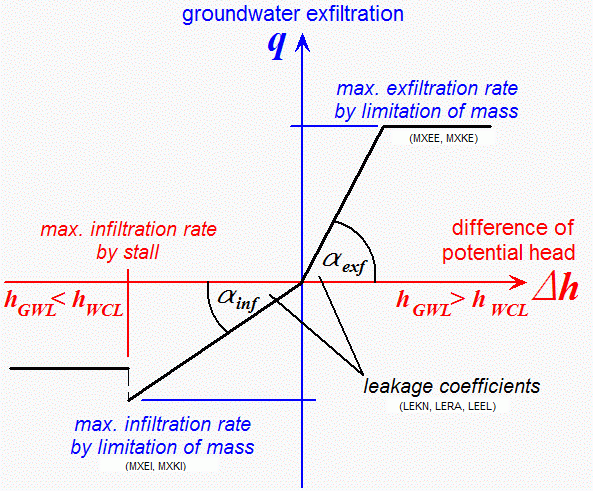If a large receiving water course exists in the model area or at the field edge, it is in most cases directly connected to the groundwater aquifer. The water level can be assigned as a fixed potential head (POTE) to the corresponding nodes. The resulting inflow or rather outflow rates are represented by mass flow rates. The process with water flowing from the aquifer into the surface water is called exfiltration. The opposite process, with water flowing from the surface water into the aquifer, is known as infiltration. In the case of smaller water courses, there is often no direct connection with the aquifer.
Because of colmation or the formation of an unsaturated zone between the surface water and the groundwater the exchange of flow is disturbed.
The following figures illustrate the various terms related to the aquifer:
|
|
|
|
|
Exfiltration of the groundwater into the water course |
Infiltration of the water course into the groundwater |
Infiltration with tear-off height |
The direction of the flow and the flow rate is determined from the mostly linear relation between the water level in the surface water and the groundwater level. The corresponding function is called leakage function. The leakage coefficient [1/s] represents the quotient between the inflow / outflow rate Q (referring to the width of the surface water and the proportional length) and the average potential difference. Especially for infiltration, there exists a maximum rate. Independent of further increase of the potential difference, the current rate will never exceed this maximum. For certain situations, limiting the exfiltration rate can also be useful.

Schematic representation of the leakage function
Predominantly, leakage functions are defined along lines. But surface leakage relationships are useful as well. SPRING provides the following input data for the definition of leakage processes

VORF: node wise height of the water level in the surface water

ABRI: Potential difference between water course and groundwater level from which the infiltration rate does not increase any more (tear-off height)

LEKN: Leakage coefficient of a node

LERA: polyline wise leakage coefficient

LEEL: Leakage coefficient for elements

LKFA: Ratio between exfiltration und infiltration at nodes (LEKN) or polylines (LERA)

LEFA: Ratio of exfiltration and infiltration in elements (LEEL)

MXKE: max. exfiltration rate of a polyline

MXEE: max. exfiltration rate for elements

MXKI: max. infiltration rate for a polyline

MXEI: max. infiltration rate for elements
Absolutely necessary data for a leakage calculation are VORF and values for one of the data sets LEKN, LERA or LEEL.
Leakage in case of impermeable layers
The water exchange through an 'impermeable' layer is a special case for surface leakage. The relatively tight layer slows down the rising of the groundwater level (see max. thickness of the groundwater aquifer), but enables water exchange processes, especially for steady state.
Leakage through an 'impermeable layer' requires the following data:

UNDU: Thickness of the impermeable layer (requires the input of the ground level GELA )

LEEL: The meaning of this value depends on the data type UNDU: UNDU>0: LEEL = vertical K-value of the impermeable layer in m/s; UNDU=0 or no input: LEEL = direct leakage coefficient in 1/time unit.

VORF: Water level of the surface water (if no surface water is existing, VORF is equal to the ground level)
In the following chapters, the practical implementation of individual water course interactions in the ground water model is explained using typical examples.
 Controlling the depth to water table with a withdrawal well
Controlling the depth to water table with a withdrawal well



